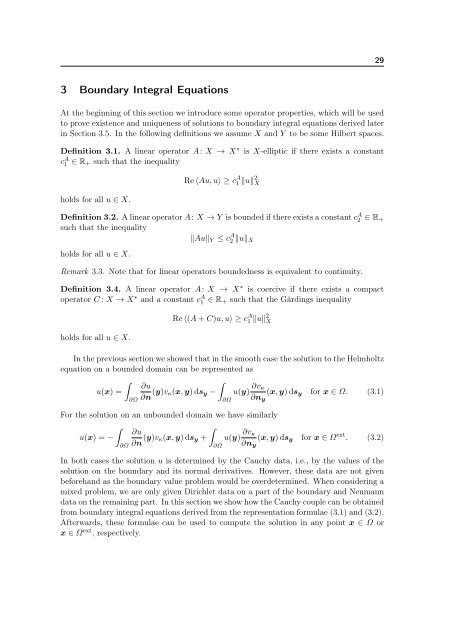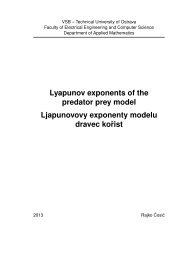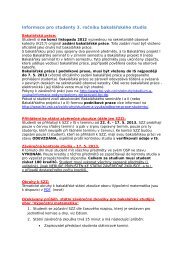The Boundary Element Method for the Helmholtz Equation ... - FEI VÅ B
The Boundary Element Method for the Helmholtz Equation ... - FEI VÅ B
The Boundary Element Method for the Helmholtz Equation ... - FEI VÅ B
Create successful ePaper yourself
Turn your PDF publications into a flip-book with our unique Google optimized e-Paper software.
293 <strong>Boundary</strong> Integral <strong>Equation</strong>sAt <strong>the</strong> beginning of this section we introduce some operator properties, which will be usedto prove existence and uniqueness of solutions to boundary integral equations derived laterin Section 3.5. In <strong>the</strong> following definitions we assume X and Y to be some Hilbert spaces.Definition 3.1. A linear operator A: X → X ∗ is X-elliptic if <strong>the</strong>re exists a constantc A 1 ∈ R + such that <strong>the</strong> inequalityholds <strong>for</strong> all u ∈ X.Re ⟨Au, u⟩ ≥ c A 1 ∥u∥ 2 XDefinition 3.2. A linear operator A: X → Y is bounded if <strong>the</strong>re exists a constant c A 2 ∈ R +such that <strong>the</strong> inequality∥Au∥ Y ≤ c A 2 ∥u∥ Xholds <strong>for</strong> all u ∈ X.Remark 3.3. Note that <strong>for</strong> linear operators boundedness is equivalent to continuity.Definition 3.4. A linear operator A: X → X ∗ is coercive if <strong>the</strong>re exists a compactoperator C : X → X ∗ and a constant c A 1 ∈ R + such that <strong>the</strong> Gårdings inequalityholds <strong>for</strong> all u ∈ X.∂ΩRe ⟨(A + C)u, u⟩ ≥ c A 1 ∥u∥ 2 XIn <strong>the</strong> previous section we showed that in <strong>the</strong> smooth case <strong>the</strong> solution to <strong>the</strong> <strong>Helmholtz</strong>equation on a bounded domain can be represented as∂uu(x) =∂n (y)v κ(x, y) ds y − u(y) ∂v κ(x, y) ds y <strong>for</strong> x ∈ Ω. (3.1)∂n yFor <strong>the</strong> solution on an unbounded domain we have similarly∂uu(x) = −∂n (y)v κ(x, y) ds y + u(y) ∂v κ(x, y) ds y <strong>for</strong> x ∈ Ω ext . (3.2)∂n y∂Ω∂ΩIn both cases <strong>the</strong> solution u is determined by <strong>the</strong> Cauchy data, i.e., by <strong>the</strong> values of <strong>the</strong>solution on <strong>the</strong> boundary and its normal derivatives. However, <strong>the</strong>se data are not givenbe<strong>for</strong>ehand as <strong>the</strong> boundary value problem would be overdetermined. When considering amixed problem, we are only given Dirichlet data on a part of <strong>the</strong> boundary and Neumanndata on <strong>the</strong> remaining part. In this section we show how <strong>the</strong> Cauchy couple can be obtainedfrom boundary integral equations derived from <strong>the</strong> representation <strong>for</strong>mulae (3.1) and (3.2).Afterwards, <strong>the</strong>se <strong>for</strong>mulae can be used to compute <strong>the</strong> solution in any point x ∈ Ω orx ∈ Ω ext , respectively.∂Ω









